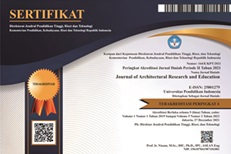ANALYSIS OF THE SYMBOLISM OF ARCHITECTURAL MEMORABILIA ON THE PATTERN OF THE OUTER SPACE ARRANGEMENT OF THE MUSEUM BUILDING
Abstract
Symbolism in architecture can represent architectural elements and be configured for a specific purpose to communicate a certain image, value, or meaning to users or observers interacting with the building. The aspect of symbolism also represents memories of an event; the event is also formed and has a storyline. In commercial buildings, there is usually a sequence of outer space arrangements towards the main building, which can provide an experience for users. This research aims to analyze the symbolism contained in architectural memorabilia in the pattern of outer space arrangements in the building site, as well as to understand its influence on users and society. The method used in the preparation of this article is direct survey, interviews with relevant parties, and literature study of qualitative journals. The results show that symbolism in architectural memorabilia can include certain cultural, historical, and religious connotations that influence the identity, emotions, and image of individuals and groups interacting with the building. These symbols can evoke feelings of admiration, pride, or tranquility and can be catalysts in building emotional bonds between users and the outer space of the building.
Keywords
Full Text:
PDFReferences
Andhika, Nugraha. (2009). Arsitektur Simbolis. https://indoarch.wordpress.com/2009/09/15/ars itektur-simbolis/. Diakses 17 Juni 2023.
Azza, M. A. R., & Anisa, A. (2019). Kajian Arsitektur Simbolik pada Bangunan Masjid. PURWARUPA Jurnal Arsitektur, 3(3), 213-220.
Bantul, diakses 17 Juni 2023 https://bantulpedia.bantulkab.go.id/layanan/pa riwisata/jelajahbantul/detail/19/66/469/yunika tour--4d3n-aceh-museum-tsunami-tour.html
Fahamsyah, R. (2002). Museum Bung Karno di Blitar Representasi Arsitektural terhadap citra Bung Karno melalui konsep Metafora Arsitektur.
Lajjah, R. V. N., & Paryoko, V. G. P. J. (2023). Analisis Pola Tata Ruang dan Pendaerahan pada Bangunan Museum. WASTU: Jurnal Wacana Sains & Teknologi, 4(2), 113-124.
Mangunwijaya, Y.B. (Yusuf Bilyarta), 1929-1999. (1988). Wastu citra : pengantar ke ilmu budaya bentuk arsitektur : Yusuf B. Mangunwijaya. Jakarta :: Gramedia,.
Rehan, R. M. (2016). The phonic identity of the city Pitri, R., Dewi, C., & Qadri, L. (2022). PERANCANGAN PUSAT SENI DAN BUDAYA DI BANDA ACEH. Jurnal Ilmiah Mahasiswa Arsitektur dan Perencanaan, 6(3), 76-80.
Riany, M., Rachmadi, Y., Sambira, I. Y., Muharam, A. T., & Taufik, R. M. (2014). Kajian aspek kosmologi simbolisme pada arsitektur rumah tinggal vernakular di Kampung Naga. Reka Karsa: Jurnal Arsitektur, 2(4).
Urwanto, E. (2020). Analisis Kompetensi Literasi Informasi dan Keterampilan Sosial terhadap Kinerja Pustakawan Perpustakaan Proklamator Bung Karno. Otonomi, 20(2), 300-310.
DOI: https://doi.org/10.17509/jare.v7i2.67843
Refbacks
- There are currently no refbacks.
Copyright (c) 2025 Journal of Architectural Research and Education

This work is licensed under a Creative Commons Attribution-NonCommercial-ShareAlike 4.0 International License.

This work is licensed under a Creative Commons Attribution-ShareAlike 4.0 International License.








